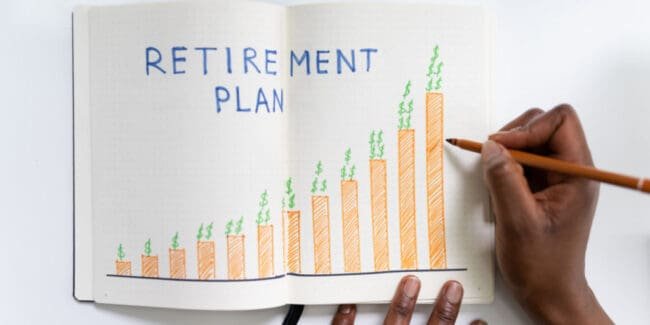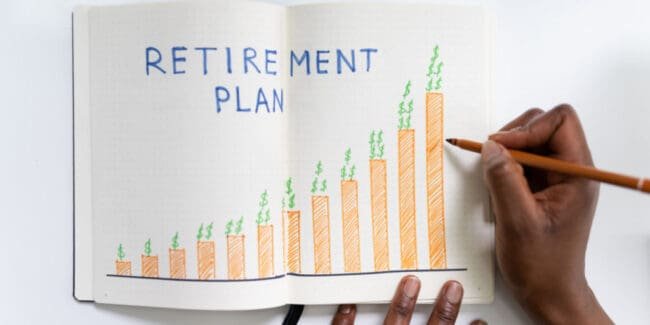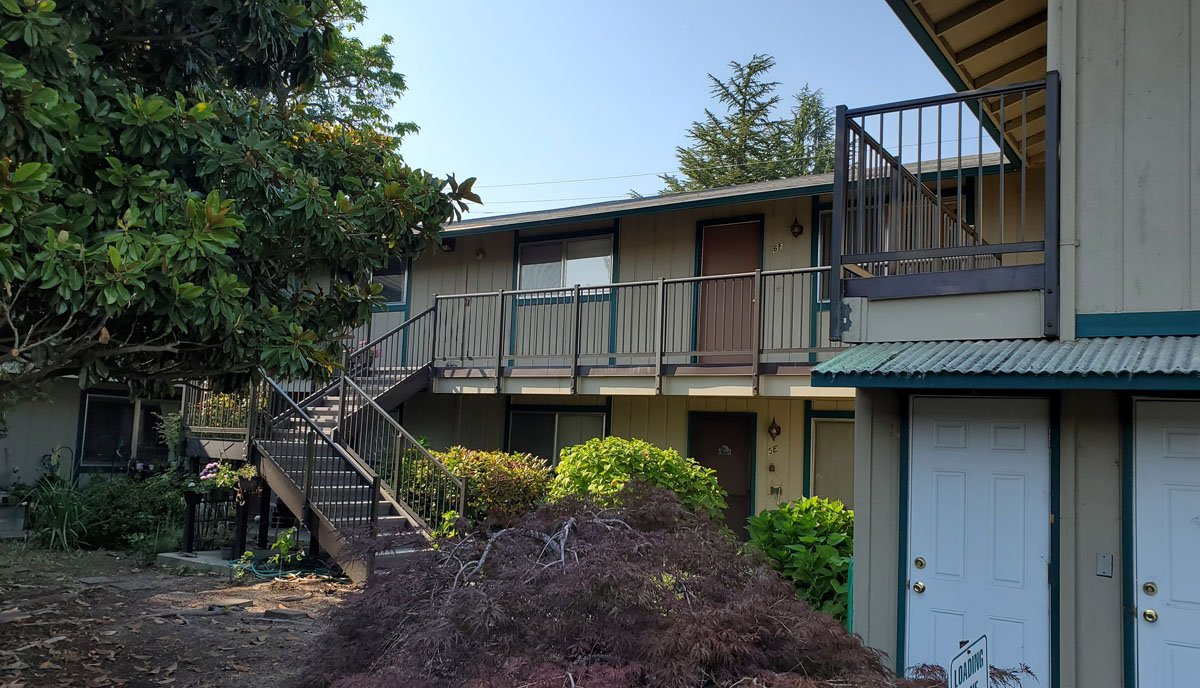After a record-high inventory market, low-interest charges from the Federal Reserve, and pandemic woes, inflation arrived.
Inflation, a basic improve in costs for items and providers, which reduces the buying energy of cash, could sound scary.
But inflation, not less than sparsely, is an element and parcel of a wholesome financial system.
When shoppers assume costs will proceed rising over time, they’re extra possible to purchase merchandise now, quite than ready till later, when merchandise is perhaps costlier.
This results in a rise in manufacturing, which implies extra jobs in our financial system.
Nevertheless, if you’re planning for retirement, higher-than-average inflation charges can eat away on the buying energy of your nest egg. So, it’s important to contemplate accounting for inflation in retirement planning.

What Causes inflation?
Inflation occurs when the sum of money coming into the financial system is extra vital than its financial progress.
If the federal government prints extra money to cowl money owed however individuals decelerate their buy of products and providers, that flood of additional {dollars} into the financial system will trigger costs to rise.
Usually, if costs of products rise, employers must elevate their wages accordingly to proceed attracting workers keen to work for them. That is very true if the unemployment fee is low and fewer persons are on the lookout for jobs.
If for some motive, wages don’t proceed to rise in tandem with the costs of products and providers, then the usual of residing for workers decreases, they usually’re not in a position to purchase as a lot or get pleasure from as excessive a top quality of life.
Inflation for Normal Inhabitants
Individuals in several elements of the nation don’t essentially really feel the results of inflation in the identical methods. Economists measure inflation by taking a look at a number of totally different figures.
Within the US, they use the Shopper Worth Index. That is an index of costs that buyers pay for hundreds of services and products in city areas (since 80% of shoppers within the US reside in city areas)
Whereas one client in Chicago could pay $3.89 for a gallon of milk, one other could solely must pay $2.49 within the Southeast.
Economists additionally issue housing prices into the overall inflation fee. However housing bills are one other value that may fluctuate quite a bit relying on what a part of the nation you reside in.
Inflation for Retirees
What does the potential of inflation imply should you’re a retiree or plan to retire within the subsequent few years?
If the prices of products and providers rise over time, then the facility of your retirement financial savings decreases. That’s, your retirement {dollars} will purchase much less for you throughout retirement than the yr earlier than.
And when you could not discover value will increase within the brief time period, the compounding impact of an inflation improve can erode your buying energy in the long run.
Most retirement plans think about a average fee of inflation, normally 3%. Nonetheless, if inflation rises to Nineteen Seventies-era ranges, that might throw off the quantity of buying energy you’ll have in retirement, particularly the longer you’re retired.
So how are you going to correctly put together for the results of inflation throughout your retirement years?
Put together for Inflation in Retirement
To assist your funds stand up to inflationary intervals when you retire, follow the next:
1. Think about Inflation in Your Retirement Planning
Most retirement simulators issue a average inflation fee into the sum of money you’ll want if you retire.
But, you could need to calculate how a lot you’d want if the financial system experiences higher-than-normal inflation ranges throughout your retirement years.
As a substitute of assuming a 3% inflation fee, calculate how a lot you would wish to maintain tempo with inflation if it have been increased.
Begin with 4% (that is most likely sensible on condition that the common inflation within the 70s, one of many highest inflation charges in trendy historical past, was solely 6.8%).
How a lot will this alteration:
- The quantity you want to save for retirement?
- Your funding methods – now and in retirement?
- Your spending means in retirement?
Accounting for inflation in retirement planning could imply pushing aside retirement, saving a bit extra, or investing in several asset courses to account for doubtlessly increased inflation charges.
Learn additionally: Healthcare Prices in Retirement – Keep away from These Massive Errors
2. Select Investments that Rise with Inflation
It’s additionally important to verify your retirement property are invested in ways in which present some inflation safety.
In case you’re invested closely in a pleasant mixture of shares, there’s an excellent likelihood that the inventory market will rise in tandem with inflation.
That is very true should you put money into index funds or exchange-traded funds (ETFs) that mirror the market, such because the S&P 500, for instance.
One other funding that is a hedge towards inflation is TIPS or Treasury inflation-protected securities. TIPS are US-issued bonds listed to inflation, so if the inflation fee goes up, so will your bond fee.
Some persons are comfy investing in different different investments, resembling gold and different valuable metals or actual property, whether or not actual property, an actual property funding belief (REITs), or crowdfunded properties, to hedge towards inflation.
Whereas some danger is important, others could take into account these investments a bit too dangerous throughout their golden years. Make certain you do your analysis earlier than including different property to your funding portfolio.
You probably have an inflation-adjusted pension, you’ve gotten a substantial safeguard towards inflation. Social Safety funds are additionally adjusted yearly to account for inflation.
Having a well-diversified retirement portfolio means the possibilities are good you’ll be better-protected to face up to just a few higher-than-average inflation years throughout your retirement.
Learn: Worthy Bonds Overview: Earn 5% Mounted Curiosity from Day 1
3. Delay Social Safety
You probably have an extended life expectancy and satisfactory retirement financial savings, delaying Social Safety advantages can provide you one other instrument to protect towards future inflation.
Annually you delay beginning Social Safety funds from 62 – 70 will present elevated advantages if you do draw.
Plus your SS funds are inflation-protected with an annual improve in advantages. You will discover an estimate of your future advantages by visiting SSA.gov and creating an account.
Some monetary recommendation you may learn suggests constructing a retirement plan that features diminished SS funds, whereas others advise not planning for it in any respect. Whereas the way forward for Social Safety remains to be unsure, it isn’t more likely to disappear.
4. Add Sources of Revenue
Aspect-gigs aren’t only for the youngins. Loads of retirees do some kind of labor for a stream of earnings as soon as they go away full-time employment.
Maybe you possibly can:
- Present consulting providers to your earlier employer or trade
- Flip a passion into an earnings supply
- Tutor highschool college students or educate ESL (English as a Second Language)
- Acquire a part-time or seasonal place
- Promote a service on-line or inside your area people (private assistant or digital help, bookkeeping, writing, enhancing, and so on.)
- Carry out home or pet-sitting providers
Along with all kinds of labor you might tackle, additionally take into account renting out house in your house or trip property you personal.
For many who would really like a “assured” paycheck in retirement, you may take into account an annuity product for a supply of lifetime earnings.
Whereas annuities aren’t for everybody, should you fear about operating out of cash should you reside previous 90, take into account a deferred annuity.
It may be an excellent possibility so as to add to your retirement plan if you’re on the lookout for an extra earnings stream for all times with out an expiration date.
5. Maintain an Eye on Spending in Retirement
One in every of your finest bets towards inflation expectations in retirement is your spend fee.
It’s possible you’ll assume your spending will stay comparatively static in retirement. The fact is, the expenditure of cash over time tends to fluctuate fairly a bit. Your most important spending sometimes happens in the beginning of retirement.
The US Bureau of Labor Statistics supplies information on spending for older Individuals.
In 2019, its Shopper Expenditure Survey confirmed common annual expenditures of $68,214 for people aged 55-64 and $55,822 for these 65-74. For these over age 75, the common was simply $43,446.
Michael Okay. Stein, a licensed monetary planner, coined the phrases “Go-Go Years,” “Sluggish Go Years,” and “No-Go Years” to explain the best way older Individuals’ spending patterns change with time.
Spending is increased for individuals of their 50s as they assist kids in faculty, repay mortgages, and journey.
Of their 60s, individuals have typically slowed down, paid off mortgages, and wish to assist grownup kids much less.
Lastly, of their 70s and past, spending drops dramatically in all classes besides healthcare and housing.
In the identical New York Instances article, Katherine Roy, a chief retirement strategist at JP Morgan Asset Administration, predicts that due to these spending tendencies, conventional retirement planning instruments “might overstate spending in late retirement by 30% or extra.”
Adjusting your spending
In case you’re keen to regulate your spending fee, particularly in hyperinflation years, you possibly can cut back the sum of money you’ll want in retirement.
The 4% rule permits you to take out 4% of your retirement portfolio per yr, adjusted for inflation.
So, if the inventory market will increase by 7% in yr 2, then you definately’d be capable to take out 4% of your portfolio and be capable to maintain a 3% annual inflation fee.
And, should you’re in a position to lower your spending, particularly over time, then chances are high superb that your portfolio will be capable to stand up to inflation over time.
Accountin for Inflation in Retirement Planning
It’s not possible to know the way a lot or not inflation charges will rise sooner or later. But, you possibly can plan for it.
A technique is by assuming a higher-than-normal inflation fee if you estimate how a lot you’ll want for retirement.
One other inflation hedge is to make sure your retirement property are in a diversified portfolio, with not less than a few of your holdings in inflation-protected investments.
Moreover, you possibly can put together to decrease your spending or add to your earnings throughout instances of inflation in retirement. This will likely be particularly helpful during times of hyperinflation.
The longer term is a query mark. Nonetheless, cautious planning and adaptability may also help you stand up to challenges like higher-than-normal inflation, even in retirement.
















